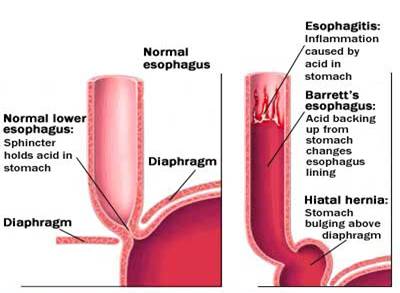Barrett’s Esophagus Causes, Symptoms, Diagnosis and Treatment

What Is Barrett’s Esophagus?
Barrett’s esophagus refers to an abnormal change (metaplasia) in the cells of the lower portion of the esophagus
It is characterized by the replacement of the normal stratified squamous epithelium lining of the esophagus by simple columnar epithelium with goblet cells (which are usually found lower in the gastrointestinal tract).
The cells of Barrett’s esophagus, after biopsy, are classified into four general categories:
- nondysplastic,
- low-grade dysplasia
- high-grade dysplasia
- Frankcarcinoma.
High-grade dysplasia and early stages of adenocarcinoma can be treated by endoscopic resection and new endoscopic therapies such as radiofrequency ablation, whereas advanced stages (submucosal) are generally advised to undergo surgical treatment.
People with Barrett’s esophagus have an increased risk of esophageal cancer. The risk is small, especially in people whose lab tests show no precancerous changes (dysplasia) in their esophagus cells.
Causes Of Barrett’s Esophagus:
The exact cause of Barrett’s esophagus isn’t known. Most people with Barrett’s esophagus have long-standing GERD.
However, some people diagnosed with Barrett’s esophagus have never experienced heartburn or acid reflux. It’s not clear what causes Barrett’s esophagus in these people.
The following factors increase the probability of developing Barrett’s esophagus:
- Chronic heartburn and acid reflux.
Risk of having Barrett’s esophagus is increased via:
Having GERD for more than five years
having GERD that requires regular medication
being older than age 50
- Age.
It is more common in older adults
- Being a man.
- Being white.
- Being overweight.
- Smoking.
Symptoms Of Barrett’s Esophagus:
Barrett’s esophagus is associated with the following symptoms:
- frequent and longstanding heartburn
- trouble swallowing (dysphagia)
- vomiting blood (hematemesis)
- pain under the sternum where the esophagus meets the stomach
- unintentional weight loss because eating is painful
Diagnosis Of Barrett’s Esophagus:
Both macroscopic (from endoscopy) and microscopic positive findings are required to make a diagnosis.
Barrett’s esophagus is marked by the presence of columnar epithelia in the lower esophagus, replacing the normal squamous cell epithelium—an example of metaplasia.
All in all, the following procedures diagnose Barrett’s esophagus:
- Endoscopy
- Biopsy
Treatment Of Barrett’s Esophagus:
Treatment depends on the degree and severity of dysplasia.
- Low grade dysplasia
Periodic endoscopy to monitor the cells in the esophagus.
Endoscopy is recommended in six months or a year.
Treatment for GERD.
Medications
Lifestyle changes can ease your signs and symptoms.
Surgery.
Treating GERD doesn’t treat the underlying Barrett’s esophagus but can help make it easier to detect dysplasia. - High grade dysplasia:
Endoscopic resection, which uses an endoscope to remove damaged cells.
Radiofrequency ablation, which uses heat to remove abnormal esophagus tissue.
Cryotherapy, which damages the abnormal cells.
Photodynamic therapy, which destroys abnormal cells by making them sensitive to light.
Surgery
By : Natural Health News




